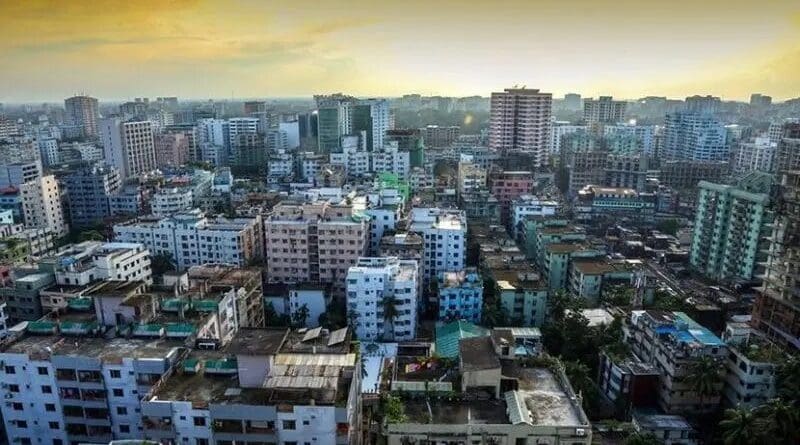Bangladesh: Looking East To Play Key Regional Role – Analysis
The strategic location of Bangladesh which connects the nations of South and Southeast Asia helps Dhaka to play a pivotal role in regional forums like Bay of Bengal Initiative for Multi-Sectoral and Economic Cooperation (BIMSTEC), ASEAN and the Forum for Regional Economic Cooperation among Bangladesh, China, India and Myanmar (BCIM). In addition to SAARC, these platforms offer excellent opportunities for Bangladesh to expand its economic, commercial and cultural ties with the neighbouring nations. The Sheikh Hasina government is keen to develop close relations with the fast growing economies of ASEAN, China and India through bilateral and multilateral mechanisms.
Bangladesh is an important member of BIMSTEC — a sub-regional grouping comprising seven geographically contiguous South and Southeast Asian nations in the Bay of Bengal, namely: Bangladesh, India, Myanmar, Sri Lanka, Thailand, Nepal and Bhutan. The third summit of heads of state and governments was held at Nay Pyi Taw in Myanmar on March 3 and 4. Formed in 2004, BIMSTEC seeks to promote cooperation and strengthen connectivity among the member countries in 14 priority sectors. Some of them include trade and investment, technology, transport and communication, energy, tourism, fisheries, environment and disaster management, counter-terrorism and transnational crime etc.
The present summit, held after a gap of six years, is significant for Bangladesh in many ways. Commerce Minister Tofail Ahmed has observed that trade issues would dominate the third summit of BIMSTEC. A number of Memoranda of Understanding (MoUs) were finalised to be signed at the summit. The sectors covered by the MoUs include energy, agriculture and tourism. Another MoU inked at the summit paved the way for establishing a secretariat in Bangladesh. BIMSTEC was initiated with the purpose of combining the “Look West” policy of Thailand and the “Look East” policy of India and Bangladesh.
Bangladesh is also an integral part of Forum for Regional Economic Cooperation among Bangladesh, China, India and Myanmar (BCIM). It was floated on Aug 17, 1999 in a regional conference held at Kunming, the capital of China’s southwestern Yunan province. BCIM is designed to integrate the region economically through market access, investment opportunities and improvement of infrastructural facilities. Bangladesh’s commerce minister has stated that the process for setting BCIM Economic Corridor is at the final stage. He said, “Once it’s set up, trade volume will increase significantly.”
Over the years, China has emerged as a key supplier of Bangladesh armed forces’ military hardware and financer of the country’s development and infrastructural projects. Sino-Bangladesh ties have been sustained by the successive governments in Bangladesh since the late 1970’s in the national interest. China also attaches importance to its relations with Bangladesh and competes with India for influence in the South Asian country. The Communist-ruled state became an observer in SAARC primarily due to Bangladeshi initiative. Both Beijing and Dhaka consider broader regional cooperation vital to stability and prosperity in the future. The quadrilateral grouping, BCIM Economic Corridor is an effort in that direction.
The proposed transnational highway and railway lines between Bangladesh and Southeast Asian states underscore the geo-strategic significance of the country in the wider regional framework and beyond. Bangladesh is one of the 31 countries associated with the highway project. The Asian Highway would link Bangladesh to 15 countries, provide improved access to Southeast Asia and eventually reduce pressure on Chittagong port. The high potential of bilateral trade with its immediate neighbour Myanmar — a key component of almost all the regional forums, has remained untapped due to the lack of shipping and road connectivity. Bangladesh-Myanmar Chamber of Commerce and Industry leaders maintain that Bangladesh stands to benefit from the coastal shipping line as import of basic commodities would be much cheaper, easier and quicker.
There is a growing realisation for widening and broadening economic cooperation between ASEAN and Bangladesh in many areas of mutual interest and benefit. Bangladesh was included in the ASEAN Regional Forum on July 28, 2006 as the 26th member. Numerous common economic and security interests persist between both the sides in areas like expansion of trade and investment, agriculture, communication, tourism, transfer of technology and counter-terrorism. ASEAN could make optimum utilisation of the low infrastructure costs, cheap labour and natural gas of Bangladesh. Though Dhaka is yet to emerge as a leading trading partner of ASEAN, the volume of trade between them has been increasing rapidly.
Bangladeshi economic analysts are of the opinion that Dhaka and ASEAN should explore the possibilities of a comprehensive trade partnership through free trade agreement. Disheartened by the tardy progress of SAARC, Bangladesh of late is looking towards its eastern horizon to pursue trade and economic interests. This new policy thrust is aimed at integrating Bangladesh’s economy with ASEAN — already an economic powerhouse.
Bangladesh’s recent strategy has been to diversify the country’s foreign economic relations in order to relieve itself from over-reliance on its giant neighbour India. Dhaka’s efforts to woo the East Asian countries such as Japan and South Korea are to be seen in the light of prevailing ground realities. Bangladesh’s foreign policymakers believe that broader engagement with ASEAN and East Asian countries would better serve its long-term strategic, economic and other interests. However, chronic political instability and crisis of governance might spoil Bangladesh’s chances of emerging as a key regional actor in the foreseeable future.
*Rupak Bhattacharjee has worked as Senior Research Fellow at Kolkata’s Maulana Abul Kalam Azad Institute of Asian Studies and New Delhi’s Institute for Conflict Management

